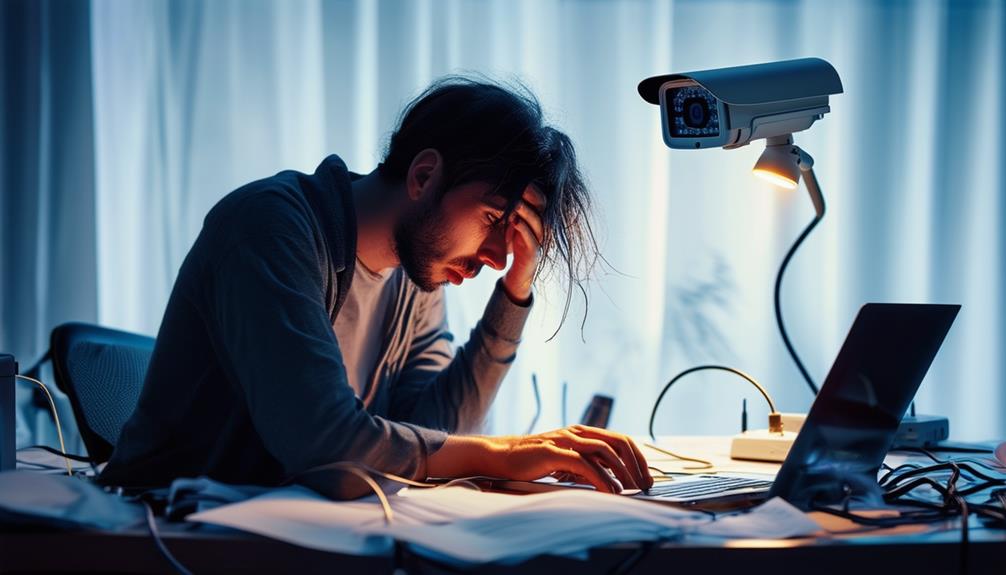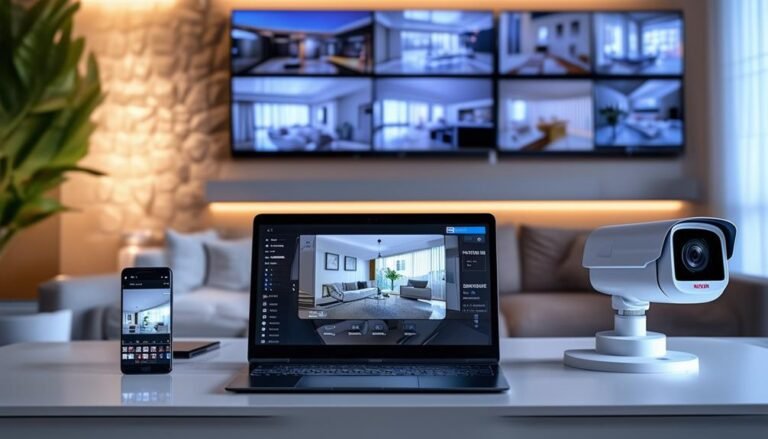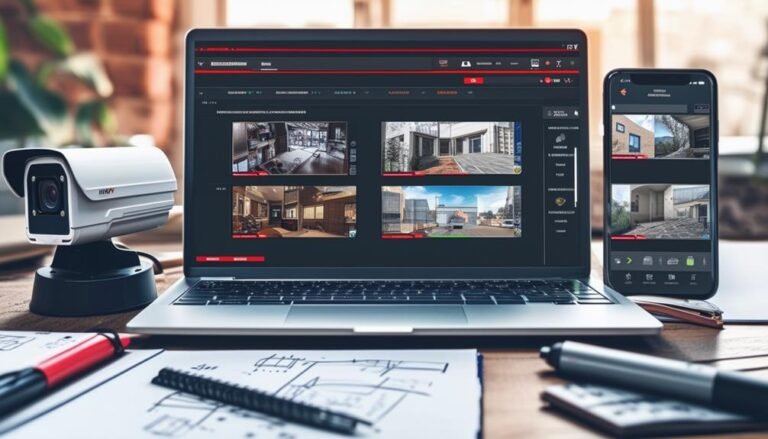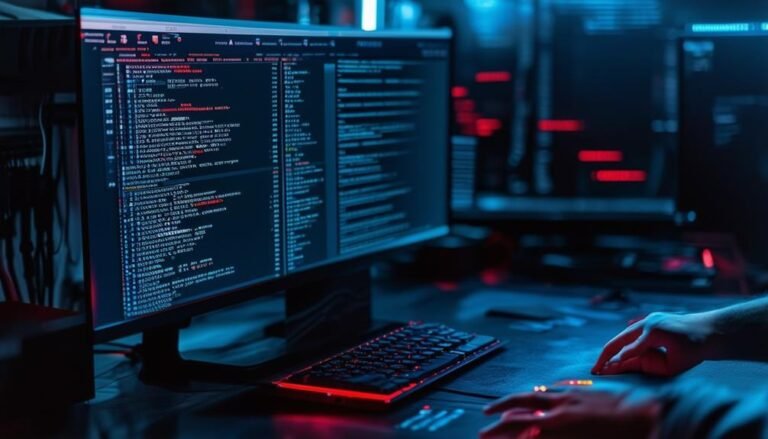If you can't connect to your Hikvision camera, don't worry—it's often due to common issues. Start by checking the power supply; make certain connections are secure and the outlet works. Then, verify your network settings, including the IP address and Wi-Fi signal strength. Outdated firmware can also cause trouble, so update it if needed. Consider resetting the camera if all else fails. Finally, remember that software conflicts may be at play, so check compatibility with apps. There's plenty more to explore on fixing these connectivity hiccups, so find out what steps you might have missed.
Common Connectivity Issues
When it comes to connecting to your Hikvision camera, there are several common issues you might encounter. First off, you may find that the camera isn't responding. This could be due to a power issue. Confirm your camera is plugged in and that the power source is functioning. If it's battery-operated, check the battery level; a low battery can disrupt connectivity.
Another common hiccup involves the camera's firmware. If you haven't updated it in a while, it could be causing problems. Firmware updates often bring important fixes that enhance your camera's performance. So, check if there's an available update and consider downloading it to keep your camera in top shape.
You might also experience difficulties with the app or software you're using. Sometimes, the app can glitch or crash. Restarting the app or reinstalling it could resolve these issues. And don't forget about your device's compatibility; verify your smartphone or computer meets the necessary requirements.
Lastly, make sure your Hikvision camera is within range of your Wi-Fi network. If it's too far, it may struggle to maintain a solid connection.
Checking Network Connections
To guarantee your Hikvision camera connects properly, checking your network connections is essential. A stable and reliable network is the backbone of any surveillance system, and without it, you might as well be flying blind. Here's what you need to focus on:
- Wi-Fi Signal Strength: If your camera's too far from the router, you might be struggling with a weak signal. Check the distance and consider repositioning your camera or router to improve connectivity.
- Router Settings: Sometimes, your router might be the culprit. Confirm that it's configured correctly and that there are no restrictions in place like MAC address filtering. You want a seamless connection, not one that feels like it's behind bars!
- IP Address Conflicts: If your camera shares an IP address with another device, it'll create chaos. Make sure your Hikvision camera has a unique IP address within your network. You can manage your devices' IPs in your router's settings.
Once you've addressed these points, take a moment to breathe and feel the freedom of knowing your camera is set up for success. Don't let connectivity issues hold you back from the peace of mind that comes with reliable surveillance. Make these checks, and you're one step closer to securing your space effortlessly!
Verifying Camera Power Supply
Before troubleshooting further, make sure your Hikvision camera is actually getting power. Check the power source and inspect the cables for any damage. Also, don't forget to verify the indicator lights to see if the camera is functioning properly.
Check Power Source
Ensuring your Hikvision camera has a reliable power source is essential for proper functionality. Without power, your camera can't capture those important moments, and it can feel frustrating when you can't keep an eye on what matters most. So, let's make sure your camera's getting the juice it needs.
- Check the Power Adapter: Make sure the power adapter's plugged in correctly and isn't damaged. A faulty adapter can mean the difference between surveillance and uncertainty.
- Verify Power Outlet: Sometimes, the problem lies in the outlet itself. Test it with another device to confirm it's working. You deserve a hassle-free setup.
- Inspect for Overheating: If your camera's power source feels hot to the touch, it might be time for a break. Overheating can lead to malfunction, jeopardizing your peace of mind.
Inspect Power Cables
If you're still having trouble connecting to your Hikvision camera, inspecting the power cables might be the next best step. A secure power supply is essential for your camera's performance, so let's make sure everything's in order. Start by checking the connections at both ends—where the cable meets the camera and where it plugs into a power source. Loose connections can lead to intermittent power, which could disrupt your connection.
Next, look for any signs of wear or damage on the cables themselves. Frayed wires or bent connectors can be a sign that your cables need replacing. If you find any issues, it's best to swap them out for new ones rather than risking further damage or connectivity problems.
Don't forget to assess the power adapter as well. If your Hikvision camera uses an external power supply, make certain it's functioning properly. You might want to test it with a multimeter or simply try a different adapter if you have one.
Taking these steps will help make certain that your camera gets the steady power it needs to work seamlessly, allowing you to enjoy the freedom of a reliable surveillance setup.
Verify Indicator Lights
One of the easiest ways to verify your Hikvision camera's power supply is by checking the indicator lights. These lights give you essential information about your camera's status, helping you reclaim that sense of security you desire. If the camera isn't working, the lights can point you in the right direction.
Here are three key indicators to look for:
- Solid Green Light: Your camera is powered and functioning correctly. Freedom restored!
- Flashing Yellow Light: The camera is trying to connect, but it's struggling. It's a reminder that you might need to check your network.
- No Light: This might mean there's no power. A disheartening sign that could lead to a deeper investigation of your power supply.
Updating Firmware
How can updating the firmware of your Hikvision camera resolve connection issues? It's crucial to understand that firmware acts as the camera's operating system, managing its functions and performance. If your camera's firmware is outdated or corrupted, it could lead to connectivity problems, making it difficult for you to access footage or control the device remotely.
By regularly checking for firmware updates, you guarantee your camera has the latest features, security patches, and bug fixes. Manufacturers, including Hikvision, release updates to enhance functionality and improve overall performance. Ignoring these updates can leave your camera vulnerable to security risks and compatibility issues.
Updating the firmware is usually a straightforward process. First, you'll want to visit the Hikvision website or access the camera's management software. Look for the latest firmware version compatible with your model. Download the update file, and then log into your camera's interface. From there, you'll find an option to upload the new firmware file. Follow the prompts, and in a short time, you'll have the latest version installed.
After updating, don't forget to reboot your camera. This guarantees the new firmware is fully integrated and can resolve any lingering connectivity issues. With the right firmware in place, you can enjoy a smoother, more reliable experience with your Hikvision camera, allowing you the freedom to monitor your space without hassle.
Configuring Network Settings
To connect your Hikvision camera, you'll need to configure the network settings properly. Start by verifying the IP address to guarantee it's in the same range as your network. Also, don't forget to check the network cables for any loose connections or damage that could impact connectivity.
Verify IP Address
Verifying the IP address of your Hikvision camera is crucial for establishing a successful connection. If you want the freedom to monitor your surroundings without interruption, ensuring your camera's IP settings are correct is key. Follow these steps to check its IP:
- Discover the Default IP: Most Hikvision cameras come with a default IP address. Consult the manual to find it, or you might miss out on critical footage.
- Use the SADP Tool: Install Hikvision's SADP (Search Active Device Protocol) tool on your computer. It'll help you discover the camera's current IP address and allow you to change it if necessary.
- Ping the Camera: Open the command prompt and ping the IP address. If you receive replies, your connection is alive and kicking, giving you the freedom to access your camera anytime.
Check Network Cables
Often overlooked, checking the network cables is essential for confirming your Hikvision camera connects properly. A loose or damaged cable can be the culprit behind your frustrating connectivity issues. Start by inspecting the Ethernet cables connected to your camera and your router or switch. Make sure they're firmly plugged in on both ends; a simple nudge can sometimes make all the difference.
Next, look for any visible signs of wear or damage. If a cable's frayed or bent, it might cause intermittent connectivity, leading to moments of disconnection. If you suspect a cable issue, try swapping it out with a new or known working cable. This can quickly identify if the cable is the problem.
Additionally, confirm you're using the right type of cable. For most setups, a Cat5e or Cat6 cable should suffice, but double-check your specific camera's requirements.
Lastly, if you're using network switches or power over Ethernet (PoE) injectors, inspect those connections as well. By confirming every cable is in top condition, you'll pave the way for a seamless connection to your Hikvision camera, granting you the freedom to monitor with confidence.
Resetting the Camera
When you're facing connectivity issues with your Hikvision camera, resetting it can often provide a quick solution. It's a straightforward process that can free you from the frustration of a non-functioning device. Before you start, make sure you've got everything you need: your camera, a power source, and a paperclip or similar tool to press the reset button.
Follow these steps to reset your camera:
- Locate the Reset Button: Usually found at the back or bottom of the camera, this small button is your gateway to restoring functionality.
- Press and Hold: Use your paperclip to press the reset button for about 10-15 seconds. You'll usually see the camera's LED indicators flashing, signaling that the reset process has begun.
- Reconnect: Once the camera powers back on, it'll revert to its factory settings. This means you'll need to set it up again, but it'll clear any previous issues blocking your connection.
After the reset, take a moment to breathe. You're reclaiming control over your surveillance setup. It's about more than just fixing a camera; it's about embracing the freedom of knowing your space is secure. Remember, technology should enhance your life, not complicate it. If the reset doesn't work, don't lose hope; there are always more avenues to explore. You're one step closer to ensuring your peace of mind.
Troubleshooting Software Conflicts
After resetting your Hikvision camera, if you're still having connectivity issues, software conflicts might be the culprit. It's important to verify that all software elements in your setup are compatible and functioning correctly. Start by checking the software you're using to access the camera, whether it's the Hikvision app or a third-party application. Sometimes, older versions may not play well with newer camera firmware, leading to connectivity problems.
Next, look into any firewall or antivirus software running on your device. These programs can block the connection between your camera and your network, thinking they're protecting you. Temporarily disabling these protections can help determine if they're the source of the conflict. Remember to re-enable them once you've completed your tests to keep your system secure.
Additionally, consider whether other applications on your device are using the same network bandwidth. If multiple applications are accessing the internet simultaneously, your camera might struggle to maintain a stable connection. Closing unnecessary applications can free up bandwidth and improve connectivity.
Lastly, if you're using a VPN, try disconnecting from it. VPNs can sometimes interfere with local network devices, including your Hikvision camera.
Seeking Professional Assistance
In challenging situations where your Hikvision camera just won't connect, seeking professional assistance can be a wise choice. You might feel frustrated, helpless, or even stuck in a situation that hinders your freedom. Instead of letting those feelings take over, consider reaching out to experts who can help restore your peace of mind and security.
Here are a few reasons why getting professional help could be the key to your freedom:
- Expertise: Professionals have the knowledge and experience to diagnose the problem quickly and accurately. They know the ins and outs of Hikvision systems and can pinpoint issues that you might overlook.
- Time-Saving: You've got better things to do than spend hours tinkering with settings and troubleshooting. By calling in experts, you can reclaim your time and focus on what truly matters in your life.
- Long-Term Solutions: Professionals don't just fix the immediate issue; they often provide lasting solutions. This means you won't have to worry about recurring problems and can enjoy uninterrupted access to your security camera.
When your camera's connection problems feel overwhelming, remember that you don't have to handle it alone. Seeking professional assistance can free you from the stress and uncertainty, allowing you to regain control of your security setup and enjoy the peace of mind you deserve. Don't hesitate to reach out when you need help; it's a step toward reclaiming your freedom.
Frequently Asked Questions
Can I Connect Multiple Hikvision Cameras to One Network?
Yes, you can connect multiple Hikvision cameras to one network. Just make sure your network can handle the additional bandwidth and that each camera has a unique IP address. You'll want to set up your router properly to avoid any conflicts. Once that's sorted, you'll enjoy the flexibility of monitoring multiple areas simultaneously. So, go ahead and expand your security setup, ensuring you feel secure and in control of your environment!
What Should I Do if My Camera Is Not Detected?
If your camera's not detected, check your connections, make certain the power's on, and confirm your network settings. Restart your camera and router to refresh the connection. Update the firmware if needed, and try using a different cable or port. Finally, consult the user manual for specific troubleshooting tips. Freedom in your surveillance system comes from knowing how to address these issues quickly and effectively, so you can monitor with confidence.
How Do I Find My Hikvision Camera's IP Address?
To find your Hikvision camera's IP address, you can use the SADP tool, which is a free software provided by Hikvision. Just download and install it on your computer. Once you launch the tool, it'll automatically search for any connected devices. You'll see a list of cameras, along with their IP addresses. If your camera's not showing up, check your network connections to verify everything's set up properly.
Is There a Mobile App for Hikvision Camera Management?
Yes, there's a mobile app for managing your Hikvision cameras, called Hik-Connect. It's pretty handy, especially since studies show that over 50% of users prefer mobile access for security management. With this app, you can view live feeds, receive alerts, and control settings right from your phone. It gives you the freedom to monitor your property wherever you are, ensuring you stay connected and in control of your security system.
What Are the Default Login Credentials for Hikvision Cameras?
The default login credentials for Hikvision cameras are usually "admin" for the username and "12345" or "123456" for the password. However, it's wise to change these defaults for security reasons. If you're looking to manage your camera effectively, always verify you're using strong, unique passwords. Keeping your system secure gives you peace of mind, allowing you to enjoy the freedom that comes with reliable surveillance and control over your property.



